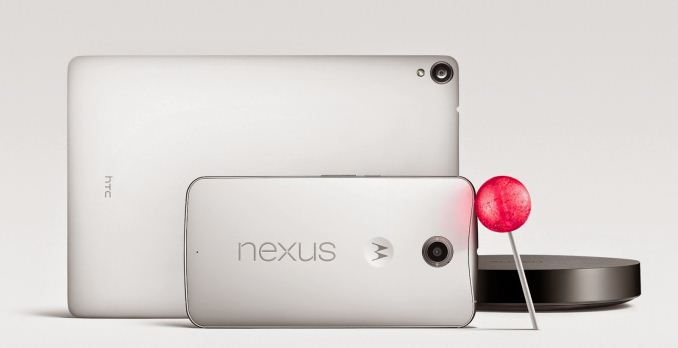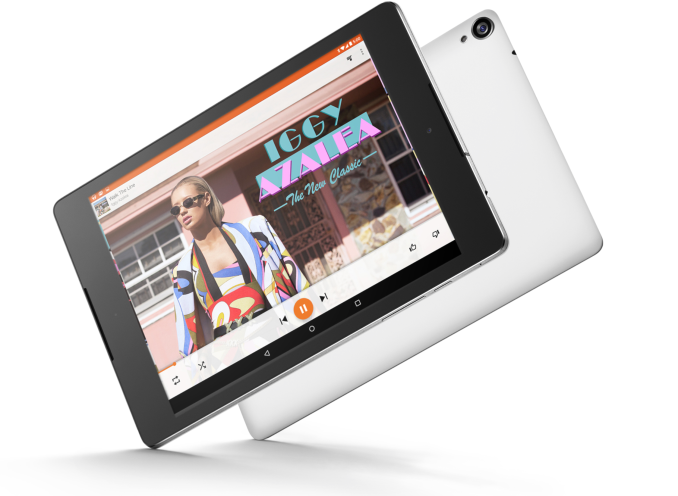Google Announces the Nexus 6 and Nexus 9 Running Android Lollipop
by Brandon Chester on October 15, 2014 12:33 PM EST
Today Google has officially announced the newest devices in the Nexus line, just one day before Apple's October event. Both devices have been rumored for some time now, and this is the first time in a while that we've seen Google introduce a new smartphone and tablet at the same time. The first device in the announcement is the Nexus 6, made by Motorola. The second is the Nexus 9 tablet made by HTC. To give an overview of how both devices look on paper, I've put together their specifications in a chart below.
| Nexus 6 | Nexus 9 | |
| SoC | 2.7GHz Snapdragon 805 (APQ8084) with 4 x Krait 450 + Adreno 420 at 600MHz | 2.3GHz 64-bit dual core Tegra K1 Denver SoC |
| RAM/NAND | 3GB LPDDR3 + 32/64GB NAND | 2GB LPDDR3 + 16/32GB NAND |
| Display | 5.96" 2560x1440 AMOLED | 8.9" 2048x1536 IPS LCD |
| Network | 2G / 3G / 4G LTE | WiFi only or 2G / 3G / 4G LTE SKU |
| Dimensions | 82.98 x 159.26 x 10.06mm, 184g | 153.68 x 228.25 x 7.95mm, 425g WiFi, 436g LTE |
| Camera | 13MP Rear Facing with F/2.0 aperture and OIS, 2MP FFC 4K video recording |
8MP Rear Facing with F/2.4 aperture, 1.6MP FFC |
| Battery | 3220 mAh (12.236 Whr) | 6700 mAh (25.46 Whr) |
| OS | Android 5.0 Lollipop | Android 5.0 Lollipop |
| Connectivity | 802.11a/b/g/n/ac + BT 4.1, USB2.0, GPS/GNSS, NFC | 802.11a/b/g/n/ac + BT 4.1, USB2.0, GPS/GNSS, NFC |
| SIM Size | NanoSIM | NanoSIM on LTE SKU |
 The Nexus 6 features a similar appearance to Motorola's other devices like the Moto X and Moto G. The plastic back is surrounded by a contoured aluminum frame that curves downward at the top where the 3.5mm headphone jack is located. On the back is Google's traditional Nexus logo, accompanied by an indented motorola logo and a centered rear-facing camera. The front is dominated by a large 5.96" display with a pixel density of 493ppi, and stereo speakers on the top and bottom bezels.
The Nexus 6 features a similar appearance to Motorola's other devices like the Moto X and Moto G. The plastic back is surrounded by a contoured aluminum frame that curves downward at the top where the 3.5mm headphone jack is located. On the back is Google's traditional Nexus logo, accompanied by an indented motorola logo and a centered rear-facing camera. The front is dominated by a large 5.96" display with a pixel density of 493ppi, and stereo speakers on the top and bottom bezels.
In terms of its specifications, the Nexus 6 is competitive with all the current Android flagship devices. It packs Qualcomm's latest silicon, a hefty battery, and a high resolution display. However, those premium specs are accompanied by a premium price of $649 outright which is significantly more than the $349 that the Nexus 5 is priced at. The Nexus 5 has been given a new web page along with the other Nexus devices which suggests it isn't going disappear with the launch of this newer, more expensive smartphone.
The next announcement was the Nexus 9 made by HTC. This is the first tablet from HTC since the days of Android Gingerbread and Honeycomb where HTC announced they were exiting the tablet market. With its soft touch back, the Nexus 9 is similar in its design to the Nexus 5. Unlike the Nexus 5 which was an entirely plastic construction, the sides of the Nexus 9 are made of brushed metal.
The front of the device is similar to the Nexus 7 with its asymmetrical bezels. The shape of the device is a departure from any tablet Google has produced before, with a 2048x1536 4:3 display like Apple's iPad. Both the 8.9" display size and 4:3 aspect ratio make the Nexus 9 a significantly larger device than the Nexus 7.
The SoC is the biggest point of interest with the Nexus 9. It will be the first device to ship with Nvidia's Project Denver architecture. This is a custom 64-bit ARMv8 architecture designed by Nvidia, a significant departure from the standard ARM cores used in previous Tegra chips. We covered the details about Tegra K1 Denver previously and you can read that over to get a more in-depth look at NVIDIA's new chip.
Along with the new device announcements comes the official name for the next version of Android. Android L is now Android 5.0 Lollipop, and it will ship on the new Nexus 6 and Nexus 9. Lollipop comes with Google's new Material Design and Google's new ART runtime, and will be rolling out to existing compatible Nexus and Google Play Edition devices in the coming weeks.
The Nexus 9 will be available for pre-order on October 17th starting at $399 for 16GB, while the Nexus 6 will be available sometime in late October at $649 for 32GB.
Source: Google Blog











148 Comments
View All Comments
agoyal - Wednesday, October 15, 2014 - link
Google is clearly moving the prices up for the Nexus line. Suspect they are trying to protect android partners like Samsung, LG, Sony etc from corroding prices of the android devices. But for us, the prices are simply too high to buy these products especially when they don't have expandable storage. I liked Nexus 7 gen 2 but it was too small and sold it. Was waiting for Nexus 9.....guess will have to look at something else, may be ipad mini esp it it gets storage bump to 64GBvarad - Wednesday, October 15, 2014 - link
Take a look at the Nvidia Shield Tab. It's 8 inches and comes with a microSD slot that you can use for additional storage.jimjamjamie - Wednesday, October 15, 2014 - link
I'm hoping for a Denver version.TheinsanegamerN - Wednesday, October 15, 2014 - link
A denver shield tablet with 64 gb of storage and the sd card would be amazing. or....what if, they made a 5 inch nvidia tablet with denver in it, and they made a controller. kinda like the original shield, but the screen would be removable. instant purchase.Impulses - Wednesday, October 15, 2014 - link
Ehh, I don't know if the motivation is to protect partners (let's face it, most phones are still sold on contract or financed) as it is a curious case of timing and the OEM they're working with this year.A metal build and K1 pushed the tablet price up. Matching flagship phablet specs in every regard and Moto's smaller manufacturing capacity might've pushed the phone price up, at the same time they're keeping the perfectly capable N5 around.
The N5 aged well and at it's year old price it still fills a price point between something like the Moto G or any current flagship. You could view it as Google adding more stratification to the Nexus line.
You can now buy a cheap Nexus as well as an expensive one, whether we're talking tablets or phones, and larger means more expensive. The last bit doesn't necessarily make sense in a purely technical sense but the entire industry has been pricing larger phones and tablets higher for years so...
TheJian - Thursday, October 16, 2014 - link
You have some kind of inside information on K1 pricing? These chips are all within $10 of each other. Even the CAR K1 solution is only $40-50 and that's due to software being so heavily used with it that is packages with the chip as a solution. I don't believe K1 goes for more than $30 and we know MS/Google got T4 for $22-25. Heck, even a small place like xiaomi got theirs for $27 IIRC in their BOM. I'm sure google didn't pay more than $35 here. Another gig of ram and an option for 64GB storage should have been mandatory here. You can blame the metal, but not the K1. Die size here is supposedly ~120, at least if Rys is on the up an up with his measurements.http://forum.beyond3d.com/showthread.php?s=ede183d...
T4 was 80mm^2. Going by die size, I'd find it hard to believe it was much more than $35, and the auto solution estimates (based on units sold, and revenue from those units) show $40-50. Again that's with a massive software solution included.
testbug00 - Thursday, October 16, 2014 - link
Ailuros agrees with Rys I would favor his word very strongly.Impulses - Thursday, October 16, 2014 - link
I stand corrected, blame the metal/HTC then... I do think the tablet could've been priced more aggressively, wasn't trying to make excuses for the prices. I think $350 might've been easier for many to swallow personally, specially if they're gonna price gouge on the keyboard, and they probably are.testbug00 - Friday, October 17, 2014 - link
indeed, $350 seems reasonable (with 32GB of storage) given that would put it $75 over the MiPad with a more premium materials build, better speakers, half the storage, and a lot of trade-offs that are about equal.That being said, the K1 chip in it makes it tempting as is... Just to have a custom ARMv8 architecture (that isn't on a locked down platform). I also imagine the screen is high quality, and, well, why can't more companies make speakers that fire towards the user :D
testbug00 - Thursday, October 16, 2014 - link
Yes, and the Mipad was ~$275 (given currency exchange from Yuan to USD has not changed much since it was announced) with 64GB of storage, a 6700mAh battery, 2GB of RAM, a 8MP rear camera, a 2048x1536 display resolution, a 5MP FFC, an SD card slot (up to 128GB).The only thing lower speced I can find on the mipad would be the body, the bluetooth version (4.0 v. 4.1) and I'm not sure if it supported wifi AC